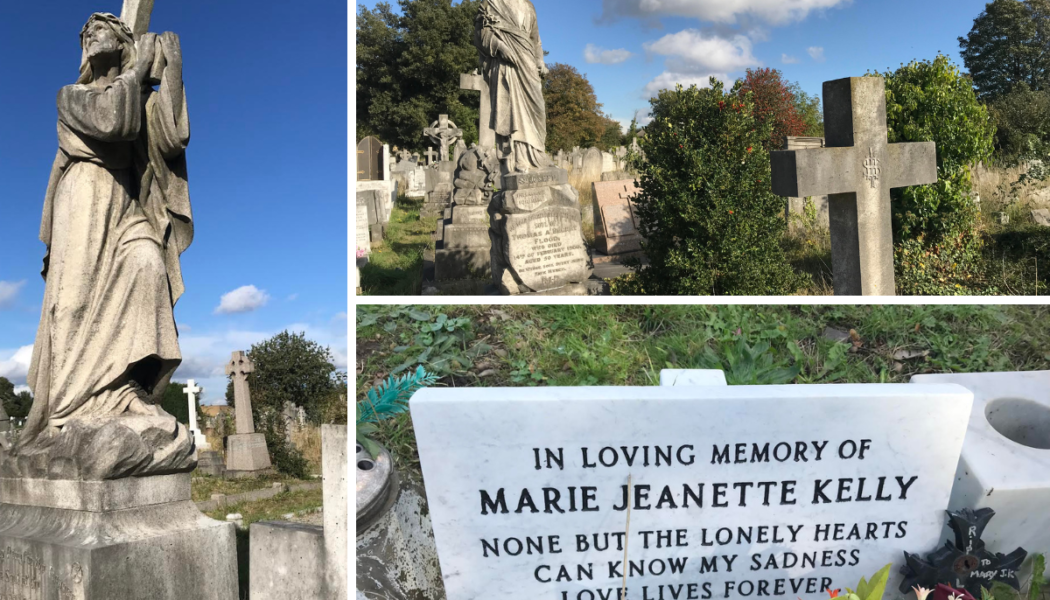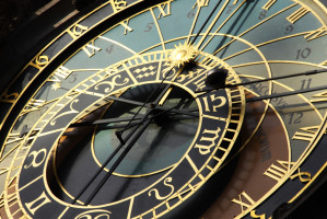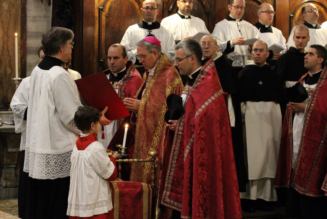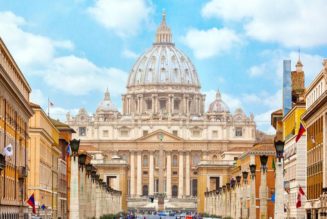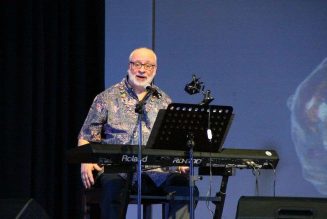LONDON — A holy and wholesome thought it is to pray for the dead, especially so during November, for this is the month in which the Church calls us to pray for the faithful departed.
London has only two Catholic cemeteries.
In the northwest of the city, St. Mary’s Cemetery, Kensal Green is the older. Opened in 1858, it is also the better known. The other is St. Patrick’s Cemetery. It lies to the east of London in the suburban district of Leytonstone. Estimates vary, but, since that cemetery’s 1868 opening, it is reckoned buried there are more than 180,000 Catholics.
Many lie in communal graves. In earlier times, these graves were known as “paupers’ graves.” They held multiple occupants, often unknown to each other in life.
Rarely were these “paupers’ graves” marked. The dead interred there were to be as quickly forgotten by the world as in life they had been overlooked. Beside these anonymous communal graves are other resting places, many still tended by loved ones, as they have been through generations. These graves are marked by headstones with incised lettering.
Today, however, many are defaced by the elements, now only possessing withered half-obliterated lettering, with any meaning long since lost to ancient rains — so much so that, to the naked eye, there seems little by way of record as to who lies buried there. These souls, in a sense all too real, are known only to God.
St. Patrick’s has no grand mausoleums like those found at St. Mary’s at Kensal Green. Instead, there are row upon row of graves of Catholics, many who appear to have been of modest means or of no means at all. In addition, there are many, very many, communal graves holding the dead of religious orders.
Some house the recently deceased, while others date back to the 19th century. Each gravestone cites the order to which the dead religious belonged and where their religious house was located. Their headstones speak of the schools, orphanages and parishes where they worked. As a consequence, unwittingly, these inscriptions chart the history of the Catholic faith in this city.
One grave that lies in the middle of those dedicated to religious orders is of particular interest. In the middle of a snowstorm, on the night of Dec. 7, 1875, the German ship Deutschland, bound for New York City, struck a sandbank off the Kent coast near the estuary of the River Thames. In the wreck, 57 passengers perished. Five of these were German Franciscan nuns. Making their way for the New World, they were fleeing religious persecution in their homeland on account of the anti-Catholic laws of German Chancellor Otto von Bismarck.
In the London press, the fate of the Deutschland was extensively covered. One who read of its sinking and of the passengers who perished was the English Jesuit poet Gerard Manley Hopkins. Reading of this tragic event, he felt compelled to compose a poem in memory of the lost and the circumstances in which they had had to leave Europe. As a result, he wrote one of his most famous poems, The Wreck of the Deutschland, noting: “Rhine refused them: Thames would ruin them.”
Yet Hopkins’ poem turns the death of the nuns into a moment of victory, almost martyrdom. Standing by the sisters’ grave today, one prays that heaven welcomed them.
In St. Patrick’s Cemetery, the majority of the names still legible on the headstones are Irish. This is to be expected, given the history of the Catholic Church in this country and city. Alongside the graves of these children of Hibernia are those of Italy, Poland, Lithuania, Malta and France, as well as many other nationalities. All give witness to the universality of the faith that this cemetery represents.
It came as surprise to find that there are many children buried at St. Patrick’s. The segment of the cemetery set aside for the young is easily found because the headstones and crosses that mark these graves are of uniformly low stature.
The names and dates on the headstones tell of children who lived but a few years, others a few months, some just hours; all memorialized by grieving parents. Standing among the graves of the very young is always poignant. It is hard not to be moved by the care and attention of loved ones leaving a remembrance to the lives of these children, doubtless reflecting the pain at such a loss.
Most of the visitors who come to St. Patrick’s Cemetery, those who have no one to mourn there, visit graves belonging to those who died in tragic circumstances. Mary Jane Kelly was buried in a pauper’s grave in 1888. However, there is a headstone marking her final resting place now, as her grave is frequently visited.

Hers was not an uncommon tale of abuse and poverty, but her life ended violently in Whitechapel as the last known victim of Jack the Ripper.
Buried not far from her is the equally tragic Timothy Evans. Hanged in 1950 for a crime of murder he did not commit, he was one of the reasons why, some 15 years later, capital punishment was all but abolished in England.
Fittingly perhaps, in the light of these macabre associations scattered throughout the cemetery, there are many gravestones belonging to the Hitchcock family. The Catholic Londoner Alfred Hitchcock grew up not far from St. Patrick’s. And, therefore, not surprisingly, many of his extended family, including his parents, are buried here.
The graves of these more notable souls lie beside those whose occupants knew little of infamy or celebrity in their lives. Now, however, such things are of no consequence to any who rest at St. Patrick’s.
What the world thought, or did not think, of them matters little now. All have become strangely equal. All are enrolled, temporarily at least, in this dormitory of the dead, awaiting one thing only: the Last Trumpet and its call to Final Judgment.
It is sobering to wander amongst these, our dead brethren. Whether we have relatives buried there or not, to be in a Catholic graveyard is to feel connected with the Church Suffering, those holy souls in purgatory. Walking through the graves of St. Patrick’s is far from a gloomy experience, however. Quite the opposite, in fact, it is strangely liberating, in that it is a reminder that all human life is passing: our joys and woes, the tragic and the mundane, the constant struggle for sanctity.
Curiously, there is a tangible sense of peace to be had amongst these graves. Stone angels and saints are the ever-watchful sentinels of this holy ground. Their granite gaze seems to tell of the finality of all our earthly endeavors.
Visiting St. Patrick’s Cemetery this November is a timely reminder that here in this earthly realm there really is no abiding city.
Eternal rest grant unto them, O Lord,
and let your perpetual light shine upon them.
May their souls and the souls of all the faithful departed rest in peace.
Amen.
